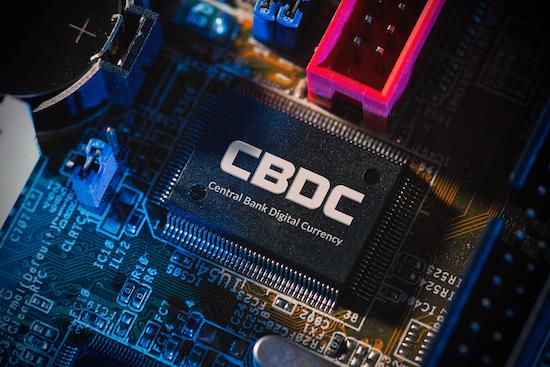Central bank digital currency (CBDC) – why go slow
National currency is a foundational element in society. A switch from material coins and banknotes, and their counting balance to a novel cyber entity comprised of a string of bits, is a big move with a lot of promise, alas facing a myriad of risks and unintended consequences. It is therefore advisable to develop a risk-mitigation strategy for this initiative.
Central banks around the world are gripped in an uncharacteristic frenzy. Almost every central bank is at least setting up “commissions” to look into the luring and jarring prospect of redefining their national currency. A few countries simply embraced Bitcoin – straight. The second economy in the world, China, is actively experimenting with a digital Yuan; President Biden issued a directive to explore, and the European Union is dead serious about the prospect.
It’s a big deal. Money is the life blood of society. It is how society manages its resources to satisfy its need for progress, and to pacify its moral conscience. Any changes in the nature of money impacts millions of individuals acting independently, creating unforeseen situations, some of them may be quite harmful. Yes, the technology is there to create a CBDC overnight, but have we thought about it long enough, and hard enough to jump into a new definition of national money?
From the point of view of society, money is a means to (i) ensure social justice, (ii) give the talented members the resources they need to translate their talent to societal benefits. On this historic occasion of transforming national currency into an independent cyber entity we must ensure that these two societal missions are well served.
Central banks need to think, plan, and simulate life when everything is paid with central bank digital currency – CBDC – and then instruct the technology to satisfy the planned requirements.
Individually we regard money as means to satisfy our will, but from a societal point of view money is a means to (i) move people in a civilised way towards societal goals, (ii) means for the more fortunate to help the less fortunate, and (iii) means to provide the talented members of society with the resources required for them to help society with their imagination and abilities.
When we stand before this historic opportunity to redefine the very nature of money we better think long and hard how to fashion it so that this switch to a new money form will properly benefit the fundamental aims of money as the bloodline of society.
CBDC will be the first form of money that can benefit from the power of cryptography. Cryptography offers security that no physical vault could rival; it offers privacy that no heavy curtains can match, and most remarkably perhaps: cryptography offers a payor the means to ensure that paid money will be used according to the terms agreed upon in the payment contract.
In other words, CBDC will be tethered money (read more in my book, “Tethered Money”); money tethered to well-defined terms. Cryptography will then send home the crowds of accountants that follow the money today; cryptography will dismiss the legions of lawyers that quarrel in courts on whether or not a certain expense is consistent with the underlying contract. The contract will be written in computer code. Money will be moved strictly according to the agreed upon computer instructions. Payment devices don’t curry favours, they execute straight.
Cryptography today though is way overplayed. The underlying mathematics is beyond the economists and the financial experts that manage central banks. They rely on superficial assurances from highly credentialed cryptographers that “all is well”, “cryptography is a reliable railway to move money on”. It is not. Not the prevailing science.
It sounds shocking to most to read that none of the ciphers used today by legacy finance or crypto finance come with a mathematical proof of efficacy.
These ciphers are in service simply because nobody published a way to crack them. Come to think about it, cracking these ciphers will credit the cracker so much financial advantage that surely they will keep it as a deep secret, and would vehemently deny the allegation that they compromised the underlying cryptography.
As we speak, the elliptic curve algorithm that is the building block of just about every crypto currency – could have been silently cracked while nobody so suspects. Wire transfer ciphers – similar vulnerability.
Complexity theory tries for decades to prove that what a cipher builder regards as complex, no hacker will see a simple way through. Cryptographers hope that this is the case, but they are not sure. They also don’t communicate their reservations to the people who run central banks, and it is left for articles like this to point it out.
Collapse of a national currency is an absolute no-no. Until we have at our disposal cryptography that relies on mathematical proof of efficacy, it will be grossly imprudent to build on it the money of the nation.
Mathematically proven cryptography is coming forth though. CBDC better wait until it is fully “cooked” (more can be found in my 2021 paper, “Pattern Devoid Cryptography”).
To come to its full power CBDC will need a dedicated financial language; universalisation, and standardisation. The tethered content will be written into the transactable coin, as well as to the accounting ledgers tracking that coin – all that must be part of the future CBDC, and it must be carefully designed. It takes time. If we rush to define the new sparkling CBDC as a payment scheme running on Ethereum then we botch this historic opportunity to come forth with a CBDC capable of delivering the historic impact one envisions.
For society to prosper, it must allocate its most talented members and give them the resources to exercise their talent. Today there are numerous of means and tools – credit, investment funds, endowments – that contend with that challenge. The advent of CBDC is to put more order, increase the efficacy of such match work between talent and resources. We just have to plan it properly. It all has to be carefully thought of, and precisely designed, guided by the bold vision of game-changing cyber money.
Whether the “Davos dream” of a world government will become an imminent reality, or not so fast, the planet surely gets intimately cross-involved, and global commerce bursts through national borders. CBDCs will have to be compatible with each other. Cyber international standards will have to be set up. A universal financial language will serve this goal better. It all takes time. It makes no sense for a national currency to forge ahead regardless of its trading partners.
Already we have preliminary thoughts about wealth-based taxation replacing today’s income-based taxation; creating a no-cheat-tax-zone – again with the power of cryptography. Big vision – takes time.
Applying to this challenge the “Innovation Solution Protocol”, it would become clear that yet unspecified innovation tracks will emerge from this technology in the near future. These yet unarticulated buds will probably wish to have a say on how a CBDC looks like.
In summary, the nature of CBDC needs its pregnancy time to be fully formed. It should not be a premature baby. Alas we may not that CBDC will impact society (i) by its very nature, and (ii) by its payment practice.
While the nature of cyber money is now slowly evolving, payment efficiency is a well understood attribute. Central banks may distinguish the nature of their future money from the practice of moving it about. The latter can be done and experimented with through the notion of stable coins. The idea is to issue digital claim checks for the national currency as is, and keep these claim checks with instant redemption ability. Digital claim checks represent obligation against cash; an obligation that came about through payment of the same amount of cash. Digital claim checks hence, don’t impact liquidity (CBDC may); they can be introduced through commercial issuers, well regulated by the central bank.
Many of the practical advantages of CBDC may be achieved with stablecoins that always redeem per their nominal value. Stablecoins, such as BitMint*LeVeL, can be tethered – guided per their use after they have been released to the payee; they can be applied to frictionless cross border payments, and are readily applicable for Internet of Things (IoT) payment. Once implemented nationwide, there will no doubt, be some snags, that will take time to overcome.
The central banks will watch. There is a distinct possibility that the set of competing stable coins will be sufficiently supportive of the societal goals of money as articulated above, rendering CBDC per se to a non-urgent development, waiting for deeper insight.
Digital money claim checks will still serve as a juicy target for fraudsters and financial criminals. The experience in running these claim checks will be helpful in determining whether the cryptographic shield is strong enough.
Same for money laundering. Sophisticated people launder enormous amounts of money. They will challenge the digital claim checks from every direction twice. Let’s learn to fend off money laundering at this digital claim check level, before we launch the CBDC.
A transformation of money similar to what is about to happen has occurred only twice in the history of money – a five thousand-year history. The first was the brilliant idea of minting precious metal coin in a fixed standard weight, and the second was the replacement of metal with paper. Each of those transformations catapulted society to new heights; expect nothing less this time around. We better get it right!
About the authors:
 Professor Gideon Samid, PhD, Electrical, Computer and System Engineering, Computer and Data Sciences, Case Western Reserve University, Cleveland, Ohio, US.
Professor Gideon Samid, PhD, Electrical, Computer and System Engineering, Computer and Data Sciences, Case Western Reserve University, Cleveland, Ohio, US.
Inventor (30+ registered patents). Innovator. Dr Samid is a thought leader, a technology developer, a teacher, an author. He built the “Innovation Solution Protocol” – a generic engine to accelerate innovation solutions in all branches of science, now maturing into AI-assisted innovation methodology.
In his role as chief technology officer (CTO) for BitMint Dr Samid designed a comprehensive cyber platform to deliver robust cryptographic security and game-changing digital money solutions.
 Amnon Samid, CEO of BitMint, an AI-powered cyber innovation company, is a veteran cybersecurity expert, lecturer and mentor.
Amnon Samid, CEO of BitMint, an AI-powered cyber innovation company, is a veteran cybersecurity expert, lecturer and mentor.
He is bridging DeFi, CeFi and people’s interests; is a member of the experts panel for stablecoins and CBDC at the Digital Euro Association; involved with the People’s Bank of China’s Digital Currency Institute since its inception in 2016 and led a digital yuan project since 2018.
Samid is also involved in promoting the LeVeL-Paying-Field protocol, that enables bilateral payment, that is homomorphic with cash payment and puts users in charge of their data, money and privacy.












































